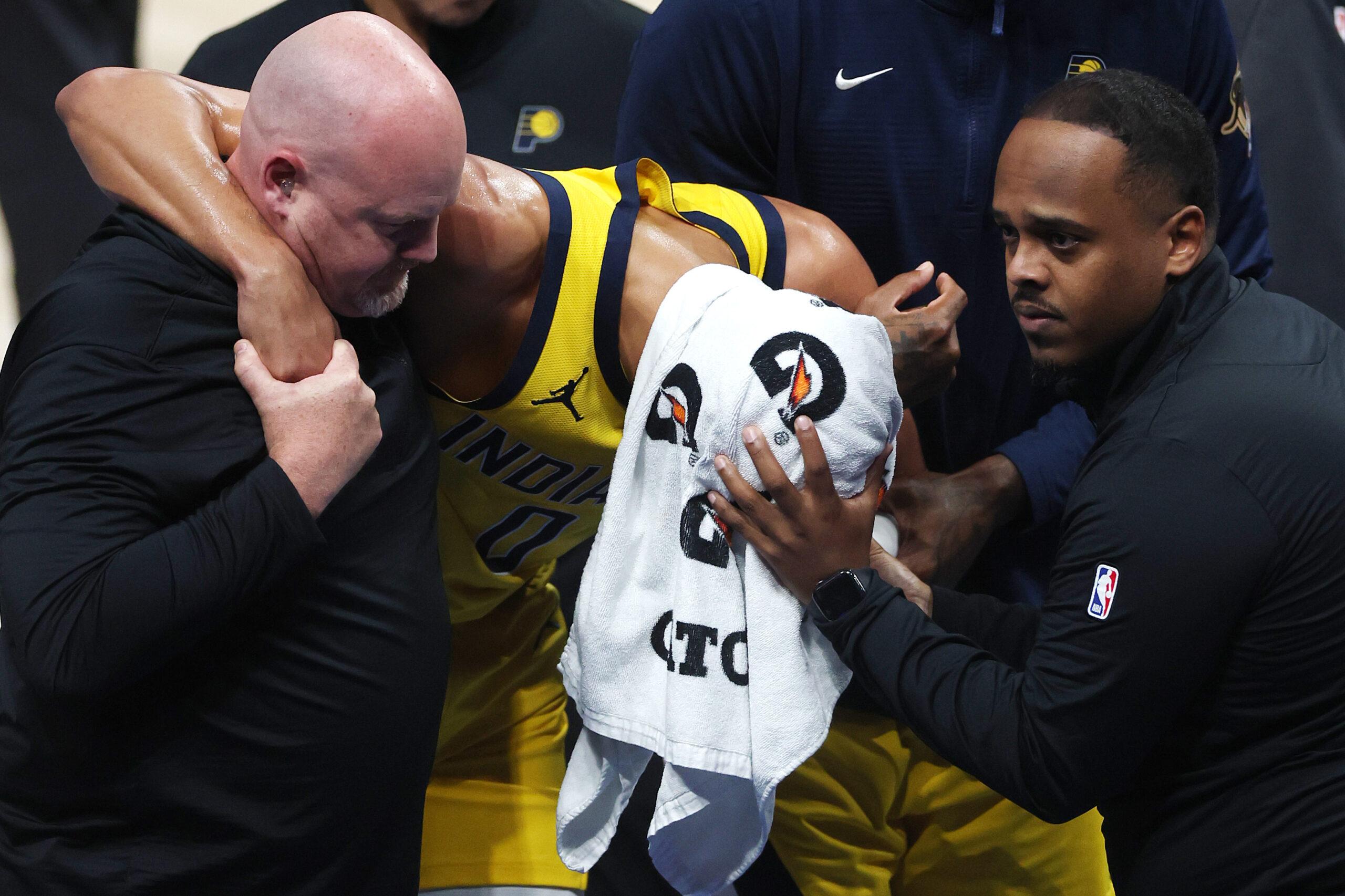
Hosts
About the episode
Sign up for the Derek Thompson newsletter.
In Game 7 of this year’s NBA Finals, Indiana Pacers guard Tyrese Haliburton tore his Achilles in the first quarter while attempting to drive to the basket on an injured calf. It was the third major Achilles injury of the 2025 NBA playoffs. Curiously, Achilles tears are typically an older-dude injury, as they’re most common in middle-aged men, according to a 2018 study published in the Journal of Biomechanics. So the sudden clustering of this injury among star athletes in their prime has inspired a lot of head-scratching among NBA fans and even in the league itself. “We had already convened a panel of experts before Tyrese’s most recent Achilles rupture,” NBA commissioner Adam Silver said.
When you zoom out from basketball and consider the broader landscape of sports, the injury surge seems quite real. In baseball, we’ve seen a huge increase in the so-called Tommy John surgery, which repairs a torn UCL in a pitcher’s elbow. In soccer, ACL injuries have been rising, particularly in women’s soccer. And that’s before we get to the huge amount of media attention that’s been paid to concussions in football.
What’s going on here? Vern Gambetta, a conditioning coach, trainer, and adviser to professional soccer, baseball, basketball, and Olympics teams, explains why major injuries might be surging across sports—and what it tells us about the risks of pushing the human body to its physical limit.
If you have questions, observations, or ideas for future episodes, email us at PlainEnglish@Spotify.com.
Summary
In the following excerpt, Derek and Vern Gambetta start to explore one of the reasons that injuries across sports are rising: the increasing specialization of athletes from a young age.
Derek Thompson: I want to structure this show, I think, a bit like a mystery, like a murder investigation. The first thing you have to do in a murder investigation is to prove that the body is actually dead. I want to make sure that there’s a mystery to solve here.
It certainly seems to me, as a nonexpert that’s just a casual sports fan, that Achilles injuries are up in basketball. Arm injuries are up—basically normal, extremely common—in baseball. Leg injuries have been more common in other sports. You are the expert here, though. Is my impression correct? Is there a surge in injuries across sports that has a set of common variables and common explanations?
Vern Gambetta: Well, I’ll be Sherlock Holmes, and you be Watson. If we look, if we start, scratch my chin, and I go, like, “What’s going on here?” I pick up the sports page today and look at the American sports page, and I look at baseball. I don’t know if this—we’re just hypothetically now, right? Last night, there was two pitchers that had to come out of games, one with shoulder, one with elbow. There’s the Copa América going on in soccer right now. Three people went out with hamstring pulls. Somebody in the WNBA tore an ACL.
In investigating with my, what do you call it, magnifying glass and looking at the data, the data supports our ear hunch, that yes, the body is dead, and absolutely, injuries have gone up or remained steady at a fairly high level. There’s common threads, though, that are interesting. I’ve had the opportunity to work in my career with 22 sports and still consult with individuals working in the high-level pro sports here in the U.S. and overseas, especially Australia and England. There’s definite commonalities.
I think they need Sherlock, because they’re not seeing the forest for the trees, is what I’m saying. What you have driving this now is what I call the medical model. I was talking with a friend of mine, Bill Knowles, who’s arguably probably the best rehab specialist in the world—did people like Tiger Woods, you name it. The surgeons are saying, “Don’t do this, don’t do that,” and the surgery heals everything. Surgery doesn’t heal. That’s the last resort.
You have a medical model that drives it. When the medical model says, “Don’t do that, be careful,” and the performance model says, “We’ve got to go ahead; we’ve got to use good principles, good training principles, what we know about the biomechanics of the body, what we know about the biomechanics of the sport, and move forward and prepare for the game we have to play,” the medical model says, “Now, wait a minute, we’ve got to have some more days off. We’re training too hard. Don’t do this, don’t do this, don’t do that.”
Thompson: That’s so interesting. I want to get back to that point in just a second, this idea that medical progress—better surgeries, improved reconstruction techniques—has changed the way athletes and teams think about injury. We’re going to put a pin in that, because it’s a thread we’re definitely going to pick up later. Before we get to specific sports, I want to ask you about a trend that I think you’ll agree spans across sports, and that is specialization, early specialization.
My friend David Epstein, the author of the great book Range, has written about how today’s student athletes are pushed to specialize in sports from a very early age. Rather than this old model of the talented athlete playing football in the fall and then basketball in the winter and then tennis or baseball in the spring, which is giving the body this kind of automatic cross-training experience, now, there’s a lot of pressure for talented young athletes to pick one sport and fill their entire lives with it.
Do you think this early specialization phenomenon is an important contributor to the rise of injuries that we’re seeing across sports?
Gambetta: No question, and worldwide. What we’ve done is we try to identify them early, and I’m talking 7, 8 years old now. Some of the tennis academies and the soccer academies are literally trying to identify down to that level. Then they become very, very narrow in their range of movements and skills. They’re very focused on that movement. … The old model of playing multiple sports, some people, the experts, call it sampling.
You sample different sports, you get a robustness, you get an adaptability where you become familiar with a lot of different movements, a lot of different positions, instead of just repetitively repeating the skills of your sport. I call it just a lack of movement literacy. There’s common movements, fundamental movements, that precede specific sports movements: reaching, bending, falling, rolling, lunging, squatting, all of those kinds of things where now, you’ve got 7-, 8-, 9-year-olds just repeating the movement of the sport.
Now you use basketball as an example: Now, you’re adding a one-on-one trainer to a 9-, 10-, 11-year-old, where they’re really working on just specific movements, a Euro-step, different things like that. They’re not preparing them for the stress of the actual sport. That would be an overriding theme that I would have. That’s the result of specialization. There’s a lot of reasons for that: the parents, this 10,000-hour myth, which is a myth, and David does a good job of talking about that in his book. Now, they’re offering NIL contracts to 10- and 11-year-olds. It’s like Jerry Maguire. Follow the money to a certain extent. Yeah.
This excerpt has been edited and condensed.
Host: Derek Thompson
Guest: Vern Gambetta
Producer: Devon Baroldi
